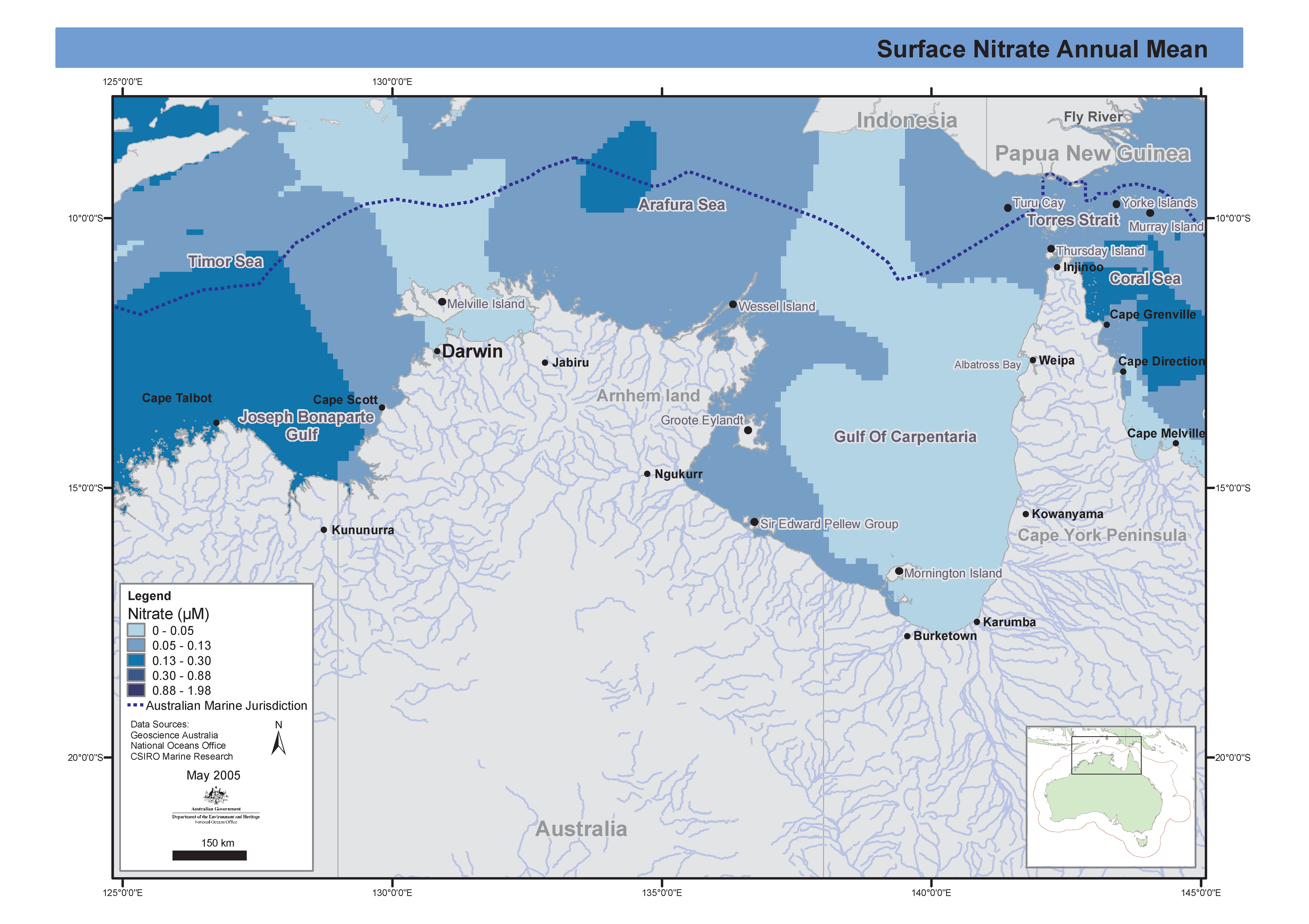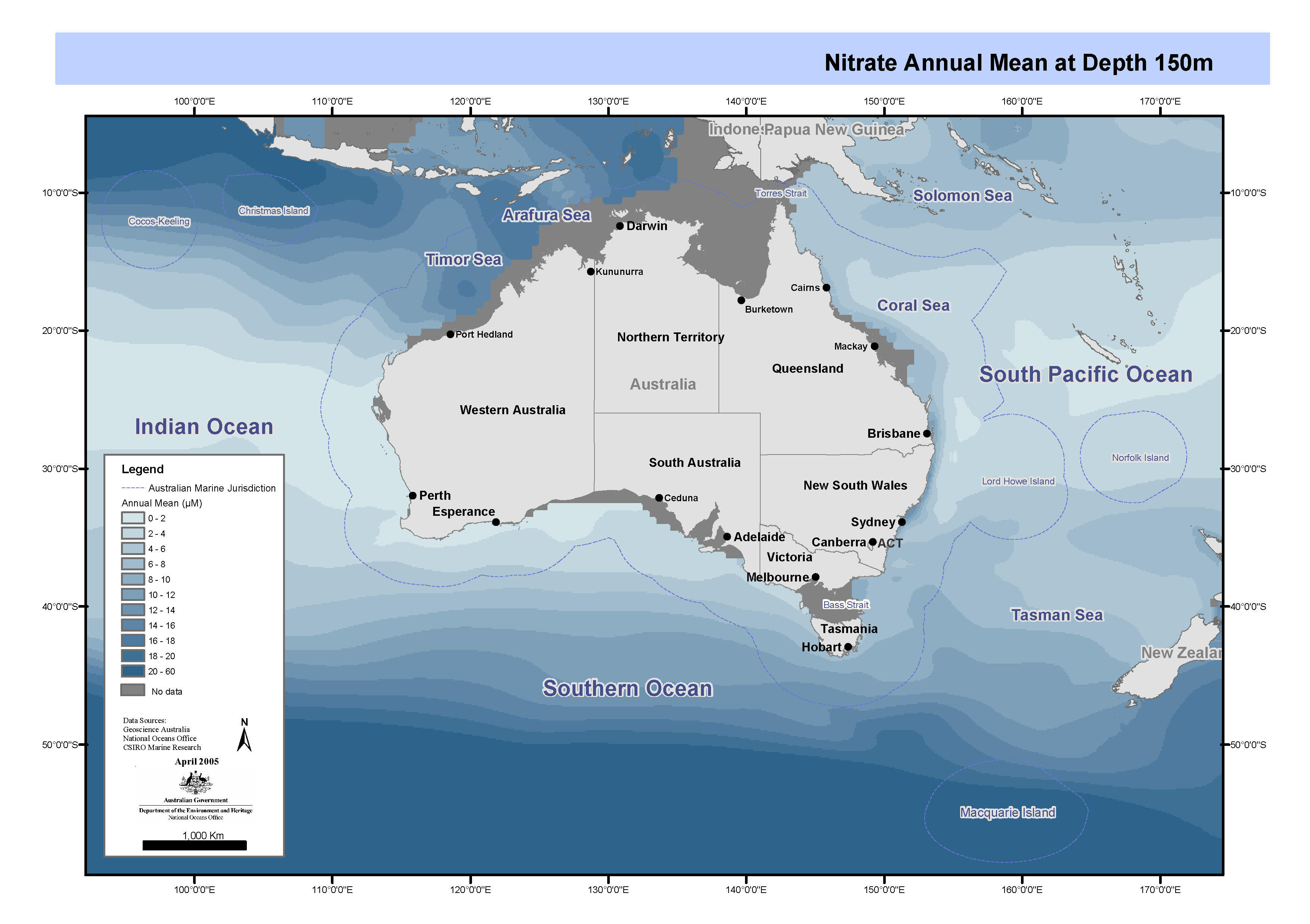Keyword
Earth Science | Oceans | Ocean Chemistry | Nitrate
798 record(s)
Type of resources
Topics
Keywords
Contact for the resource
Provided by
Formats
Update frequencies
Status
draft
-
ESRI grids showing nitrate, linearly interpolated from CARS2000 mean and seasonal fields to 0.1 degree spaced grid, at depths of 0, 150, 500, 1000 and 2000 metres. The loess filter used to create CARS2000 resolves at each point a mean value and a sinusoid with 1 year period (and in some cases a 6 month period sinusoid - the "semi-annual cycle".) The provided "annual amplitude" is simply the magnitude of that annual sinusoid. CARS is a set of seasonal maps of temperature, salinity, dissolved oxygen, nitrate, phosphate and silicate, generated using Loess mapping from all available oceanographic data in the region. It covers the region 100-200E, 50-0S, on a 0.5 degree grid, and on 56 standard depth levels. Higher resolution versions are also available for the Australian continental shelf. The data was obtained from the World Ocean Atlas 98 and CSIRO Marine and NIWA archives. It was designed to improve on the Levitus WOA98 Atlas, in the Australian region. CARS2000 is derived from ocean cast data, which is always measured above the sea floor. However, for properties which do not change rapidly near the sea floor, this would not lead to a significant error. All the limitations of CARS2000 also apply here.
-

Map showing the annual mean of nitrate in the Northern Marine Region produced from CARS2000 mean and seasonal fields 0.1 degree spaced grid. This map has been produced by CSIRO for the National Oceans Office, as part of an ongoing commitment to natural resource planning and management through the 'National Marine Bioregionalisation' project. Variations in onscreen colour representation or printed reproduction may affect perception of the contained data.
-

Set of maps showing sea surface nitrate linearly interpolated from CARS2000 mean and seasonal fields to 0.1 degree spaced grid. These maps form part of a series of maps showing the variation of temperature, salinity, oxygen, silicate, phosphate, and nitrate in Australia's Oceans. Each feature in the series has been separately mapped at depths of 0, 150, 500, 1000 and 2000 metres. These maps have been produced by CSIRO for the National Oceans Office, as part of an ongoing commitment to natural resource planning and management through the 'National Marine Bioregionalisation' project.
-
Nitrate, linearly interpolated from CARS2000 mean and seasonal fields to 0.1 degree spaced grid, at depths of 0, 150, 500, 1000 and 2000 metres. The loess filter used to create CARS2000 resolves at each point a mean value and a sinusoid with 1 year period (and in some cases a 6 month period sinusoid - the "semi-annual cycle".) The provided "annual amplitude" is simply the magnitude of that annual sinusoid. CARS is a set of seasonal maps of temperature, salinity, dissolved oxygen, nitrate, phosphate and silicate, generated using Loess mapping from all available oceanographic data in the region. It covers the region 100-200E, 50-0S, on a 0.5 degree grid, and on 56 standard depth levels. Higher resolution versions are also available for the Australian continental shelf. The data was obtained from the World Ocean Atlas 98 and CSIRO Marine and NIWA archives. It was designed to improve on the Levitus WOA98 Atlas, in the Australian region. CARS2000 is derived from ocean cast data, which is always measured above the seafloor. However, for properties which do not change rapidly near the seafloor, this would not lead to a significant error. All the limitations of CARS2000 also apply here.
-

This dataset contains temperature, salinity and nutrient data collected off Marmion, Perth, Western Australia between June 1979 and June 1982. 33 surveys were carried out at approximately monthly intervals on transects and/or grid surveys in this region. Nutrients measured comprise nitrate, reactive silicate, inorganic phosphate, nitrite, and dissolved organic phosphate (DOP). Observations on weather conditions and water quality accompany the printed version of the data. The surveys were undertaken to obtain baseline information for the Division of Fisheries & Oceanography Coastal Ecology research program established at Marmion in the late 1970s. Full listings of the surveys and results are presented in the documentation. The locations of the sampling stations are indicated in the attached map (see "Links" section).
-
NetCDF version of the NODC World Ocean Atlas 2005 (Climate and Forecasting Metadata conventions conforming) to supply the CSIRO and broader scientific community with a machine transparent, portable and self-describing version of the World Ocean Atlas 2005 (National Oceanographic Data Centre, 2006; Locarnini et al., 2006; Antonov et al., 2006; Garcia et al.,2006a,b) dataset. This Atlas is referred to by the National Oceanographic Data Center (NODC - http://www.nodc.noaa.gov) with the identifier WOA05. NODC offers the WOA05 in ASCII text format that is highly portable but not generally compact, self-describing or very efficient for processing and visualising. The ASCII or netCDF version of the WOA05 can be used to initialise numerical models, verify numerical model solutions, or for general oceanographic and meteorological analysis and can be imported into most plotting and analysis tools, or numerical models, that can read netCDF files. Contains temporal and spatial representation of in-situ temperature, salinity, oxygen and dissolved inorganic nutrients at 1 X 1 deg resolution with standard levels for the analysed fields of 0, 10, 20, 30, 50, 75, 100, 125, 150, 200, 250, 300, 400, 500, 600, 700, 800, 900, 1000, 1100, 1200, 1300, 1400, 1500, 1750, 2000, 2500, 3000, 3500, 4000, 4500, 5000 and 5500 metres.
-
Temperature, salinity, oxygen, silicate, phosphate, and nitrate, linearly interpolated from 1/8 degree spaced "high resolution" CARS2000 mean and seasonal fields to a 0.1 degree spaced grid. Values obtained for seafloor by vertical linear interpolation, which is possible because CARS2000 is mapped to one depth level below seafloor by least squares quadratic filter projection of horizontally and vertically adjacent data points. The loess filter used to create CARS2000 resolves at each point a mean value and a sinusoid with 1 year period (and in some cases a 6 month period sinusoid - the "semi-annual cycle".) seafloor_10thdeg.nc.gz contains only mean values and not seasonal values as CARS do not resolve seasonal cycles below 1000m depth, and most of this region is deeper than 1000m. CARS is a set of seasonal maps of temperature, salinity, dissolved oxygen, nitrate, phosphate and silicate, generated using Loess mapping from all available oceanogrpahic data in the region. It covers the region 100-200E, 50-0S, on a 0.5 degree grid, and on 56 standard depth levels. Higher resolution versions are also available for the Australian continental shelf. The data was obtained from the World Ocean Atlas 98 and CSIRO Marine and NIWA archives. It was designed to improve on the Levitus WOA98 Atlas, in the Australian region.
-
emperature, salinity, oxygen, silicate, phosphate, and nitrate, linearly interpolated from 1/8 degree spaced "high resolution" CARS2000 mean and seasonal fields to a 0.025 degree spaced grid. Values obtained for seafloor by vertical linear interpolation, which is possible because CARS2000 is mapped to one depth level below seafloor by least squares quadratic filter projection of horizontally and vertically adjacent data points. The loess filter used to create CARS2000 resolves at each point a mean value and a sinusoid with 1 year period (and in some cases a 6 month period sinusoid - the "semi-annual cycle".) The provided "annual amplitude" is simply the magnitude of that annual sinusoid.CARS is a set of seasonal maps of temperature, salinity, dissolved oxygen, nitrate, phosphate and silicate, generated using Loess mapping from all available oceanogrpahic data in the region. It covers the region 100-200E, 50-0S, on a 0.5 degree grid, and on 56 standard depth levels. Higher resolution versions are also available for the Australian continental shelf. The data was obtained from the World Ocean Atlas 98 and CSIRO Marine and NIWA archives. It was designed to improve on the Levitus WOA98 Atlas, in the Australian region.
-
Nutrients in Albatross Bay, Gulf of Carpentaria, northern Australia, were examined monthly between August 1991 and April 1992. Levels of nitrate, nitrite, phosphate and silicate were measured, at four sites, at different depths in the water column.
-
This dataset contains the Hydrology (HYD) data collected on Franklin voyage FR 03/1985. The voyage took place in the Tasman and Coral Seas during 8-27 June 1985. This dataset has been processed and archived within the CSIRO Marine and Atmospheric Research Data Centre in Hobart. Additional information regarding this dataset is contained in the cruise report for this voyage and/or the data processing report (as available). Franklin on-voyage hydrology data are typically obtained from water samples collected in Niskin bottles at various depths during each CTD cast. Parameters measured normally comprise temperature, salinity, dissolved oxygen, phosphate, nitrate, silicate and nitrite.
